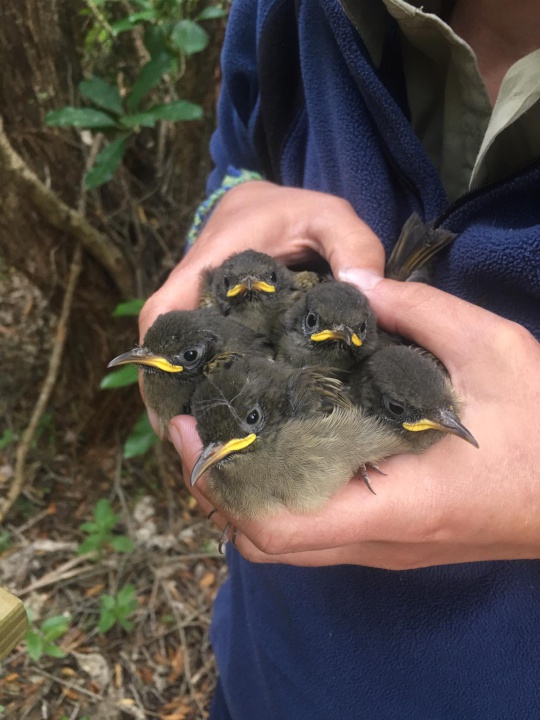Bumper hihi breeding season on pest-free Tiritiri Matangi
HCCT / DOC Media Release
Monday March 11,
2019
Bumper hihi
breeding season on pest-free Tiritiri Matangi
A record number of hihi or stitchbird have fledged on pest-free Tiritiri Matangi Island in the Hauraki Gulf Marine Park during the latest breeding season.
Hihi breeding on Tiritiri Matangi starts in late September and runs until February.

Five 21-day old hihi chicks
fledged on pest-free Tiritiri Matangi in the Hauraki Gulf
Marine Park. photo Leani Oosthuizen
This breeding
season 252 new birds were added to the hihi population on
Tiritiri Matangi.
That beats the previous record of 241 hihi fledged on the island during the 2010 / 2011 breeding season.
“Conditions have been ideal for hihi on Tiritiri Matangi this summer and breeding pairs on the island have produced a record number of new birds,” says Hihi Conservation Charitable Trust (HCCT) Conservation Officer Mhairi McCready.
“Around 150 fledgling hihi are produced in an average breeding season on Tiritiri Matangi so this is a fantastic result for this nationally vulnerable native bird.”
“It’s also a reward for the volunteers, research students and others involved in supporting the hihi during the breeding season,” says Mhairi McCready.
Hihi were once found throughout the North Island and on a number of islands. But had disappeared from mainland North Island by the mid-1880s due to introduced predators such as rats and cats, diseases spread by introduced birds and habitat loss.
In the 1890s, the last surviving hihi were found on only one island, Te Hauturu ō Toi / Little Barrier Island, in the Hauraki Gulf.
Efforts to bring hihi back from the brink of extinction began in the 1980s. Hihi from Te Hauturu ō Toi / Little Barrier Island were released on other islands, including Tiritiri Matangi in 1995. This translocation was a great success and hihi have thrived on Tiritiri Matangi.
“The success of the hihi breeding programme on Tiritiri Matangi is due to a lot of hard work by the Department of Conservation (DOC), Supporters of Tiritiri Matangi, the HCCT and research institutions,” says HCCT Trustee Dr John Ewen, who is a Senior Research Fellow at the Zoological Society of London.
“We use the best science-based methods and work together to drive recovery of this little known taonga species,” says Dr Ewen.
The hihi population on Tiritiri Matangi is very important to the national recovery programme for the species. Most of the new populations of hihi, established at other pest-free sites, began with translocations of birds from Tiritiri Matangi.
There are now hihi populations at seven pest-free sites: Zealandia sanctuary in Wellington, Kapiti Island Nature Reserve, Bushy Park Sanctuary north of Whanganui, Rotokare Scenic Reserve in Taranaki, Sanctuary Mountain Maungatautari in Waikato, Tiritiri Matangi Scientific Island Reserve and Te Hauturu ō Toi /Little Barrier Island Nature Reserve.
“Going from one hihi population to seven proves that
with dedicated effort we can recover native species from the
brink of extinction,” says HCCT Trustee and DOC Technical
Advisor Lynn Adams.
“Hihi are still a threatened species. We continue to support existing populations and are looking to establish new populations at pest-free sites where hihi are safe to breed.”
“A core value of
our recovery efforts is to reconnect New Zealanders with
this charismatic and colourful native bird. Having more hihi
flying around in more places will help re-establish this
‘ray of sunshine’ as a bird every New Zealander
knows,” says Lynn Adams.


 Gordon Campbell: On The Left’s Electability Crisis, And The Abundance Ecotopia
Gordon Campbell: On The Left’s Electability Crisis, And The Abundance Ecotopia NZ Police: New Zealand Police team up with Z Energy, NZTA and ACC to remind Kiwis to drive safe this Easter
NZ Police: New Zealand Police team up with Z Energy, NZTA and ACC to remind Kiwis to drive safe this Easter NZCAST: NZCAST Leads Ongoing Cross-Agency Collaboration To Break Down Barriers For Survivors Of State Abuse
NZCAST: NZCAST Leads Ongoing Cross-Agency Collaboration To Break Down Barriers For Survivors Of State Abuse Regional and Unitary Councils Aotearoa: Regional And Unitary Councils Back A Practical FWFP System
Regional and Unitary Councils Aotearoa: Regional And Unitary Councils Back A Practical FWFP System NZ Government: Stay Safe On Our Roads This Easter
NZ Government: Stay Safe On Our Roads This Easter YWCA: Global Push Back Against Gender Equality A Growing Crisis In Aotearoa
YWCA: Global Push Back Against Gender Equality A Growing Crisis In Aotearoa Te Pāti Māori: Ngarewa-Packer - Fast-Tracking Seabed Mining Ignores Māori Opposition And Environmental Precedent
Te Pāti Māori: Ngarewa-Packer - Fast-Tracking Seabed Mining Ignores Māori Opposition And Environmental Precedent


